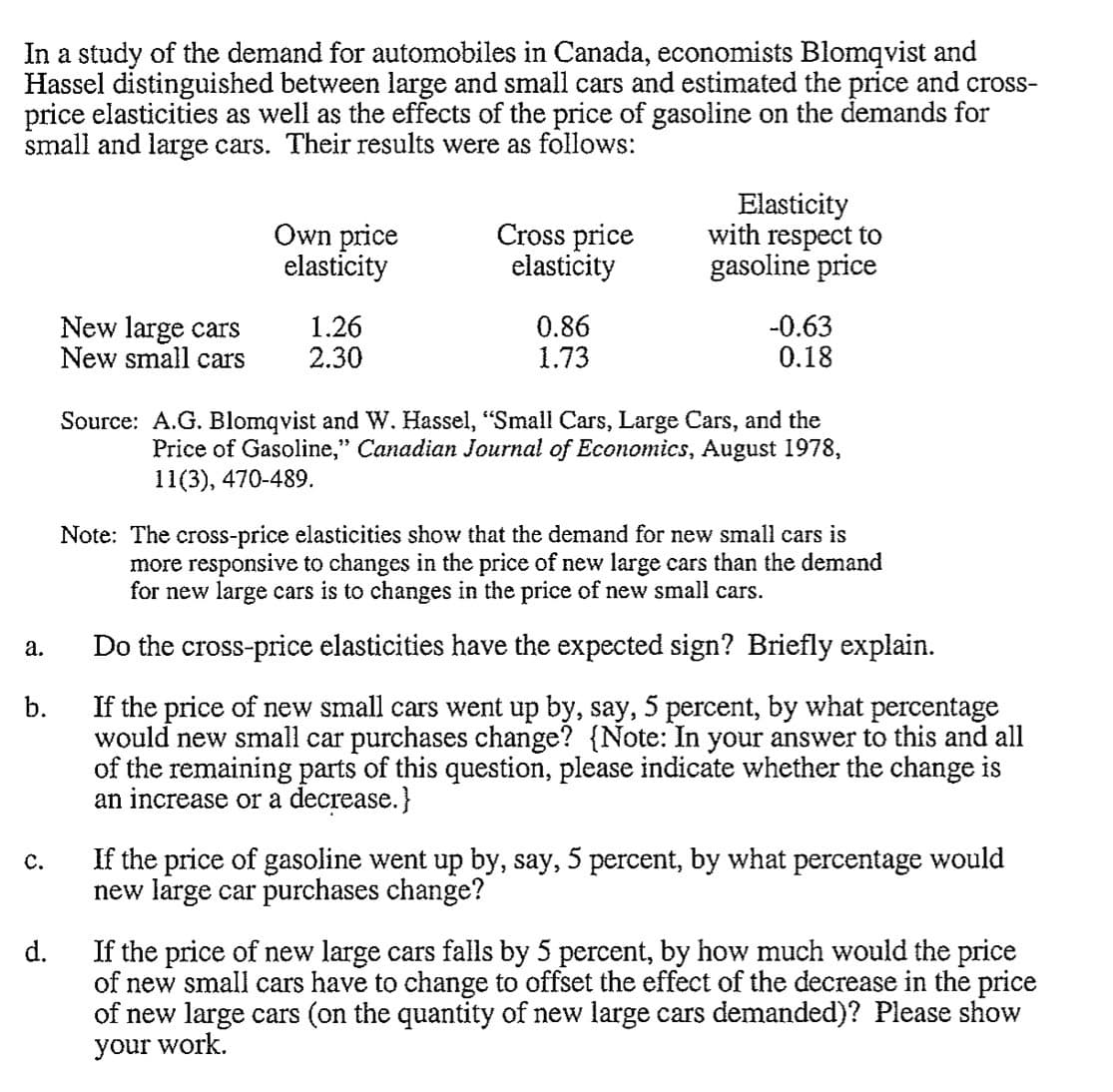n a study of the demand for automobiles in Canada, economists Blomqvist and Hassel distinguished between large and small cars and estimated the price and cross- price elasticities as well as the effects of the price of gasoline on the demands for mall and large cars. Their results were as follows: 1. 0. . New large cars New small cars Own price elasticity 1.26 2.30 Cross price elasticity 0.86 1.73 Elasticity with respect to gasoline price -0.63 0.18 Source: A.G. Blomqvist and W. Hassel, “Small Cars, Large Cars, and the Price of Gasoline," Canadian Journal of Economics, August 1978, 11(3), 470-489. Note: The cross-price elasticities show that the demand for new small cars is more responsive to changes in the price of new large cars than the demand for new large cars is to changes in the price of new small cars. Do the cross-price elasticities have the expected sign? Briefly explain. If the price of new small cars went up by, say, 5 percent, by what percentage would new small car purchases change? {Note: In your answer to this and all of the remaining parts of this question, please indicate whether the change is an increase or a decrease.} If the price of gasoline went up by, say, 5 percent, by what percentage would new large car purchases change?
n a study of the demand for automobiles in Canada, economists Blomqvist and Hassel distinguished between large and small cars and estimated the price and cross- price elasticities as well as the effects of the price of gasoline on the demands for mall and large cars. Their results were as follows: 1. 0. . New large cars New small cars Own price elasticity 1.26 2.30 Cross price elasticity 0.86 1.73 Elasticity with respect to gasoline price -0.63 0.18 Source: A.G. Blomqvist and W. Hassel, “Small Cars, Large Cars, and the Price of Gasoline," Canadian Journal of Economics, August 1978, 11(3), 470-489. Note: The cross-price elasticities show that the demand for new small cars is more responsive to changes in the price of new large cars than the demand for new large cars is to changes in the price of new small cars. Do the cross-price elasticities have the expected sign? Briefly explain. If the price of new small cars went up by, say, 5 percent, by what percentage would new small car purchases change? {Note: In your answer to this and all of the remaining parts of this question, please indicate whether the change is an increase or a decrease.} If the price of gasoline went up by, say, 5 percent, by what percentage would new large car purchases change?
Chapter20: Elasticity: Demand And Supply
Section: Chapter Questions
Problem 6E
Related questions
Question

Transcribed Image Text:In a study of the demand for automobiles in Canada, economists Blomqvist and
Hassel distinguished between large and small cars and estimated the price and cross-
price elasticities as well as the effects of the price of gasoline on the demands for
small and large cars. Their results were as follows:
a.
C.
New large cars
New small cars
d.
Own price
elasticity
1.26
2.30
Cross price
elasticity
0.86
1.73
Elasticity
with respect to
gasoline price
Note: The cross-price elasticities show that the demand for new small cars is
more responsive to changes in the price of new large cars than the demand
for new large cars is to changes in the price of new small cars.
Do the cross-price elasticities have the expected sign? Briefly explain.
b.
If the price of new small cars went up by, say, 5 percent, by what percentage
would new small car purchases change? {Note: In your answer to this and all
of the remaining parts of this question, please indicate whether the change is
an increase or a decrease.}
-0.63
0.18
Source: A.G. Blomqvist and W. Hassel, "Small Cars, Large Cars, and the
Price of Gasoline," Canadian Journal of Economics, August 1978,
11(3), 470-489.
If the price of gasoline went up by, say, 5 percent, by what percentage would
new large car purchases change?
If the price of new large cars falls by 5 percent, by how much would the price
of new small cars have to change to offset the effect of the decrease in the price
of new large cars (on the quantity of new large cars demanded)? Please show
your work.
Expert Solution
This question has been solved!
Explore an expertly crafted, step-by-step solution for a thorough understanding of key concepts.
Step by step
Solved in 2 steps

Knowledge Booster
Learn more about
Need a deep-dive on the concept behind this application? Look no further. Learn more about this topic, economics and related others by exploring similar questions and additional content below.Recommended textbooks for you








